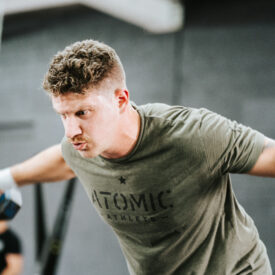TRAINING PHILOSOPHY
- Posted
- by Coach Jake
Oftentimes, people ask how we are different from other training companies and methodologies.
This was a difficult question to answer in the early years, but over the past decade we’ve continually developed our methods by working with thousands of athletes from different backgrounds and disciplines.
We do not have a “style” of programming
Brands or companies tend to find a certain method of training and label it as their own and promise almost superhuman results.
They’ll find a specific piece of equipment, a training protocol, clever format, or simply place exercises into a unique circuit. They call it functional, give it an awesome name, slap a cool logo on it, market it hard on social media with a high production video and become the next big thing.
The best training model out there is the one which addresses the unique and specific demands of your sport, profession, or goals. To do this, you must use different methods for different athletes.
Our “style” of training varies from program to program.In order to be successful, different methods must be used.
Exercise selection, training frequency, volume, and intensity are critical components we manipulate in order to create intelligent training programs to create the desired fitness.
We define Fitness differently than others
To us fitness is:
Possessing the physical ability to perform at the desired level of your sport, or profession.
This means 1 rep maxes, timed metabolic assessments, or other gym based numbers can be irrelevant if improved performance in your sport or profession is not occurring .
Stepping away from the numbers driven mindset prevalent in most gyms is challenging for many athletes. The idea of leaderboards is only applicable to the gym rats who train for the sole purpose of improving gym numbers.
We use the most effective tool for the job
Certain exercises and movements used in modern day “functional fitness” programs require a large amount of technical ability which oftentimes has nothing to do with an athlete’s sport or profession.
Although gymnastics and Olympic Weightlifting are amazing sports we love to watch, they don’t have a place in most athlete’s training programs. The time required to become proficient enough to utilize them to build strength and conditioning is simply not the most effective use of time for most athletes.
We focus on using the most effective tools for the job. We favor basic squatting, hinging, pressing, and pulling exercises to build strength. Bodyweight movements to build strength endurance, and single mode activities to build conditioning and endurance.
With all our programs we strive to provide the highest return on investment for training time. We avoid the unnecessarily complex movements which are more trouble than they are worth.
We do not Assess Daily, we Train daily
Many programs prescribe maximal effort on a daily, or near daily, basis. The reasoning behind frequent maximal assessments runs counter to data and logic. These programs conflate the idea of legitimate mental training through high intensity training will produce a mind which can override your body’s response to stress. These programs claim the mind is primary to physical performance, and high intensity training will give you as much, if not more, benefit as other training intensities in less time. This is nonsense.
Although training should be extremely taxing at times, the body’s response to stress is not one that can be overridden with simple will power. Applying the proper doses of high and low intensity training is critical in any program to ensure continued progress and avoid injury/overtraining.
We use assessments to measure progress, set training intensities, and prescribe individual training volumes. Once these have been established, we train specific intensities appropriate for the athlete’s phase of training.
Mental toughness training is suggested, but the athlete should reserve that type of training for specific times of the training year.
More is not always better
There is a fine line between hard and stupid.
Training, at times, will be hard. But a clear understanding of human physiology tells us that after the body experiences a certain amount of stress, adaptation occurs. Additional stress adds no value. Quite contrary, additional volume and stress will increase required recovery time and therefore reduce training frequency. Additionally, when extremely high volumes are prescribed, the chances of injury increase dramatically.
We believe Discipline is king
Desire is not enough to be successful in life or athletic endeavors. There is no shortcut to greatness or high levels of fitness. In order to reach your true potential you must not only have intelligent programming appropriate for your needs but the discipline to adhere to it.
All too often people are lured in with promises of “six-pack shortcuts” and “programs that get you shredded.” The athlete has to understand that there is no substitute to hard work, commitment, and dedication. Trust the process, the results will come.



